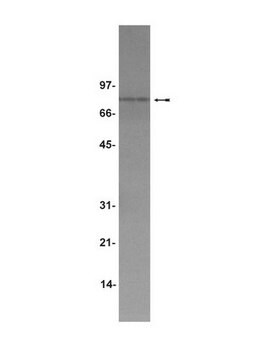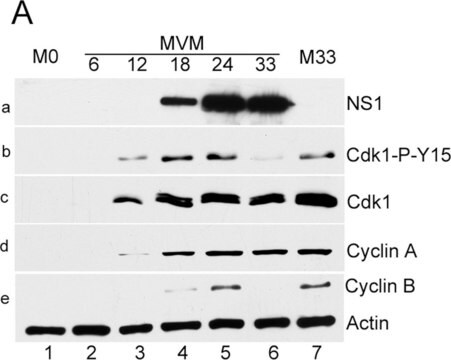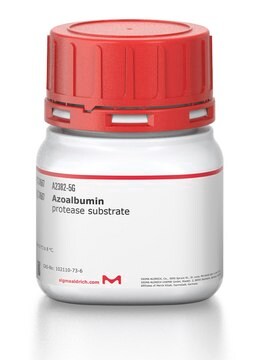07-095
Anti-PP2A-methylesterase/PME-1 Antibody
Upstate®, from rabbit
Autenticatiper visualizzare i prezzi riservati alla tua organizzazione & contrattuali
About This Item
Codice UNSPSC:
12352203
eCl@ss:
32160702
NACRES:
NA.41
Prodotti consigliati
Origine biologica
rabbit
Livello qualitativo
Forma dell’anticorpo
purified immunoglobulin
Tipo di anticorpo
primary antibodies
Clone
polyclonal
Reattività contro le specie
human, rat, mouse
Produttore/marchio commerciale
Upstate®
tecniche
western blot: suitable
Isotipo
IgG
N° accesso NCBI
N° accesso UniProt
Condizioni di spedizione
dry ice
modifica post-traduzionali bersaglio
unmodified
Informazioni sul gene
human ... PPME1(51400)
Specificità
Protein Phosphatase Methylesterase-1
Immunogeno
A mixture of two nickel agarose-purified, His6-tagged, bacterial expressed human Protein Phosphatase Methylesterase-1 (PME-1) fragments (residues 225-302 and 277-387). These two fragments represent the carboxyl-terminal portion of the protein.
Applicazioni
Research Category
Signaling
Neuroscience
Signaling
Neuroscience
Research Sub Category
Neurotransmitters & Receptors
Neurodegenerative Diseases
Neurotransmitters & Receptors
Neurodegenerative Diseases
This Anti-PP2A-methylesterase/PME-1 Antibody is validated for use in IP, WB for the detection of PP2A-methylesterase/PME-1.
Qualità
routinely evaluated by immunoblot on RIPA lysates from mouse 3T3 fibroblasts
Descrizione del bersaglio
44kDa
Stato fisico
0.1M Tris-glycine, pH 7.4, 0.15M NaCl, 0.05% sodium azide before the addition of glycerol to 30%
Format: Purified
Protein A chromatography
Stoccaggio e stabilità
2 years at -20°C
Risultati analitici
Control
Positive Antigen Control: Catalog #12-305, 3T3/A31 lysate. Add 2.5 μL of 2-mercapto-ethanol/100 μL of lysate and boil for 5 minutes to reduce the preparation. Load 20 μg of reduced lysate per lane for minigels.
Positive Antigen Control: Catalog #12-305, 3T3/A31 lysate. Add 2.5 μL of 2-mercapto-ethanol/100 μL of lysate and boil for 5 minutes to reduce the preparation. Load 20 μg of reduced lysate per lane for minigels.
Note legali
UPSTATE is a registered trademark of Merck KGaA, Darmstadt, Germany
Esclusione di responsabilità
Unless otherwise stated in our catalog or other company documentation accompanying the product(s), our products are intended for research use only and are not to be used for any other purpose, which includes but is not limited to, unauthorized commercial uses, in vitro diagnostic uses, ex vivo or in vivo therapeutic uses or any type of consumption or application to humans or animals.
Non trovi il prodotto giusto?
Prova il nostro Motore di ricerca dei prodotti.
Codice della classe di stoccaggio
10 - Combustible liquids
Classe di pericolosità dell'acqua (WGK)
WGK 1
Certificati d'analisi (COA)
Cerca il Certificati d'analisi (COA) digitando il numero di lotto/batch corrispondente. I numeri di lotto o di batch sono stampati sull'etichetta dei prodotti dopo la parola ‘Lotto’ o ‘Batch’.
Possiedi già questo prodotto?
I documenti relativi ai prodotti acquistati recentemente sono disponibili nell’Archivio dei documenti.
Single-pot enzymatic synthesis of Dicer-substrate siRNAs.
Guiley, KZ; Pratt, AJ; MacRae, IJ
Nucleic Acids Research null
Kesava Asam et al.
PloS one, 12(12), e0189413-e0189413 (2017-12-19)
Soluble forms of oligomeric beta-amyloid (Aβ) are thought to play a central role in Alzheimer's disease (AD). Transgenic manipulation of methylation of the serine/threonine protein phosphatase, PP2A, was recently shown to alter the sensitivity of mice to AD-related impairments resulting
Ha Yin Lee et al.
Science signaling, 11(512) (2018-01-11)
Cancer cells increase glucose metabolism to support aerobic glycolysis. However, only some cancer cells are acutely sensitive to glucose withdrawal, and the underlying mechanism of this selective sensitivity is unclear. We showed that glucose deprivation initiates a cell death pathway
Agnieszka Staniszewski et al.
The Journal of neuroscience : the official journal of the Society for Neuroscience, 40(23), 4596-4608 (2020-04-29)
Beta-amyloid (Aβ) is thought to play a critical role in Alzheimer's disease (AD), and application of soluble oligomeric forms of Aβ produces AD-like impairments in cognition and synaptic plasticity in experimental systems. We found previously that transgenic overexpression of the
E Ogris et al.
The Journal of biological chemistry, 274(20), 14382-14391 (1999-05-13)
Carboxymethylation of proteins is a highly conserved means of regulation in eukaryotic cells. The protein phosphatase 2A (PP2A) catalytic (C) subunit is reversibly methylated at its carboxyl terminus by specific methyltransferase and methylesterase enzymes which have been purified, but not
Il team dei nostri ricercatori vanta grande esperienza in tutte le aree della ricerca quali Life Science, scienza dei materiali, sintesi chimica, cromatografia, discipline analitiche, ecc..
Contatta l'Assistenza Tecnica.







